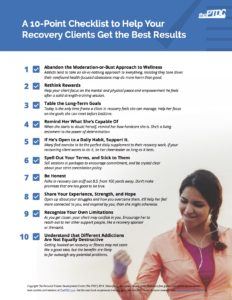I’m a trainer who works with dozens of clients who are in recovery. I’m also a recovering alcoholic and addict who, before becoming a trainer, was one of those clients.
Since I’ve been on both sides, I can tell you two things with near-certainty:
- At some point in your career, you will work with a client in recovery, if you haven’t already.
- You can expect your work with this population to feel different from your work with clients who’ve never been trapped in the abject insanity of addiction.
Here are 10 ways to help these clients get the best results.
1. Abandon the Moderation-or-Bust Approach to Wellness
Addicts like me tend to take an all-or-nothing approach to everything we do. So when we leave behind addictive substances and destructive behaviors, it’s not unheard of for us to go overboard with the good stuff—exercise, healthy eating, even 12-step meetings—especially when we’re first getting sober.
As with any other disadvantaged population, you’ve got to be willing to work with us as we are.
While daily double doses of meetings, combined with two-hour workouts and strict South Beach adherence, isn’t ideal or sustainable, insisting we tone down or moderate our newfound health-focused obsessions may do more harm than good.
Instead, help us keep moving forward for as long as we can.
Then, if we burn out, help us laugh it off while we search for a more sustainable approach to this whole healthy-living thing.
2. Rethink Rewards
“Meet your cardio goal three days this week, and then reward yourself!” might sound motivating to you, but to a recovering client it makes cardio like a B.S. obligation.
Why does that matter? Because when he was still trapped in addiction, life felt like a B.S. obligation, and the reward for tolerating it was the drink, hit, or fix after all the boxes were checked.
In recovery, many of us discover that the satisfaction and pleasures of living well are the greatest reward. The same goes for exercise. Help your client focus on the mental and physical peace and empowerment he feels after a solid strength-training session. Help him notice and appreciate the deep pleasure that only exercise can bring.
Do that, and your client will have an easier time developing a fitness habit for life. (Hell, this isn’t bad advice for any client, recovering or not.)
3. Table the Long-Term Goals
Ever wonder why the recovery slogan “one day at a time” helps people stay sober? It’s because we can’t fathom making difficult, loving, consistent decisions for a week, never mind for the rest of our lives. So we focus on what we need to do today. We’ll worry about tomorrow when it gets here.
Trainers, of course, make our living by helping clients achieve long-term goals like weight loss or increased strength. But neither goal can be met today. Since today is the only time frame a client in recovery feels she can manage, help her focus on the goals she can meet before bedtime.
The long-term payoffs will accumulate the way everything else does: one day at a time.
4. Remind Her What She’s Capable Of
Maintaining an exercise habit can be harder than showing up for work after a Vegas weekend, especially for a client who’s juggling all the trappings of an engaged, sober life. Odds are, she can handle 30 minutes a day of training, but she may need your help to feel like that’s true.
When she starts to doubt herself, remind her how hardcore she is: Not only did she survive a life-threatening addiction, she managed to pull herself out of it! She’s a living testament to the power of determination.
And now, on top of staying sober, she’s hitting the gym every day and cooking more meals at home? How awesome can one human be?
5. If He’s Open to a Daily Habit, Support It
When an addict breaks with a destructive daily pattern, there tends to be a huge hole in the fabric of his days. Meetings, therapy, and fellowship with others in recovery all help, but may not fill the hole completely. Many of us find exercise to be the perfect daily supplement to the work we do on our hearts and heads.
That’s hard for some trainers to accept. They’re used to clients who might be overwhelmed or scared away by the thought of training every day.
But if your recovering client wants to do it, be her cheerleader. Her full, sober life is bound to get in the way at some point, and she’ll likely end up doing three to five workouts a week anyway.
When that happens, again, help her laugh it off and keep going.
6. Spell Out Your Terms, and Stick to Them
You should always discuss your cancellation policy with a new client, along with any other terms you have. That goes double for a client in recovery.
Why?
Well, hold onto your seat, but we addicts are not always the most reliable grapes on the vine.
I recommend selling sessions in packages to encourage commitment, and being crystal clear about your strict cancellation policy. (Mine is 24 hours, no exceptions.) I use language in my welcome packet that anticipates no-shows and deals with them before they happen:
“Missed sessions or sessions cancelled with less than 24 hours’ notice are forfeited by the client, and will not be refunded or rescheduled. This policy is enforced 100 percent of the time, and should not be taken personally. Thank you for understanding.”
7. Be Honest
Addiction is a crash course in how to hide, lie, and manipulate. Because we’re so good at it ourselves, folks in recovery can sniff out B.S. from 100 yards away. Your client will know if you’re making promises that are too good to be true, and it will erode the trust she needs to maintain her half of the trainer-client relationship.
So instead of promising extreme weight loss, for example, talk up the sensual benefits of regular exercise—greater comfort, deeper sleep, more energy.
8. Share Your Experience, Strength, and Hope
As trainers, we sometimes shy away from revealing stories about ourselves that show our flaws. But for an addict in recovery, there’s no more powerful teaching tool than listening to someone who’s been low talk about how he brought himself back up.
If you’ve overcome your own battles—with obesity, depression, self-sabotage—don’t hesitate to open up to your client about it.
Don’t embellish (see #7), and don’t equate your disappointing semester abroad with her year in prison. But do open up about your struggles and how you overcame them. It’ll help her feel more connected to you, and inspired by you, than she might otherwise.
9. Recognize Your Own Limitations
As you get closer, your client may confide in you, and look to you for guidance, about issues beyond fitness—a relationship, a mental-health issue, or even a relapse. While you may feel honored, don’t feel you need to have all the answers.
Encourage her to reach out to her other support people, like a recovery sponsor or therapist.
10. Understand that Different Addictions Are Not Equally Destructive
Many addicts who put down the bottle, pipe, or pill turn around and pick up a doughnut, cigarette, or scratch ticket. While the latter three may be less dangerous than the crutches they replaced, they’re still not doing the addict any favors.
But this isn’t true of all addiction swaps. Getting hooked on recovery or fitness may not seem like a good idea, but the benefits are likely to far outweigh any potential problems.
If a client in recovery hires you because he wants to dive into the deep end, it’s not your job to temper his fire. Teach him the safest ways to get the best results.
Final Thoughts
I’ve done my best to share advice that I believe will apply to most people in recovery, no matter the substance they’re recovering from. In my experience, sober alcoholics and addicts tend to have a lot in common. But as with any population, you have to work with each client as an individual with unique strengths and weaknesses, using your best judgment when there’s no clear answer or path forward.
When in doubt, ask how you can be more supportive. You won’t meet many addicts who don’t appreciate the thought.
Review it again: Download and print our 10-point checklist for quick reference the next time you're training clients in recovery (click the image below to download)











